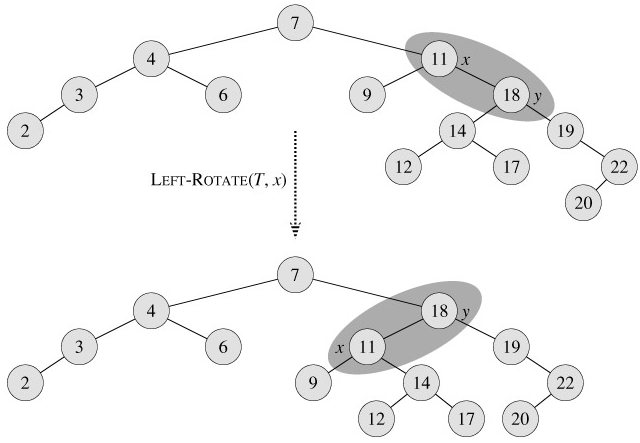SKEDSOFT
Rotations: The search-tree operations TREE-INSERT and TREE-DELETE, when run on a red-black tree with n keys, take O(lg n) time. Because they modify the tree, the result may violate the red-black properties enumerated in Section 13.1. To restore these properties, we must change the colors of some of the nodes in the tree and also change the pointer structure.
We change the pointer structure through rotation, which is a local operation in a search tree that preserves the binary-search-tree property. Figure 13.2 shows the two kinds of rotations: left rotations and right rotations. When we do a left rotation on a node x, we assume that its right child y is not nil[T]; x may be any node in the tree whose right child is not nil[T]. The left rotation "pivots" around the link from x to y. It makes y the new root of the subtree, with x as y's left child and y's left child as x's right child.

The pseudocode for LEFT-ROTATE assumes that right[x] ≠ nil[T] and that the root's parent is nil[T].
LEFT-ROTATE(T, x) 1 y ← right[x] ▹ Set y. 2 right[x] ← left[y] ▹ Turn y's left subtree into x's right subtree. 3 p[left[y]] ← x 4 p[y] ← p[x] ▹ Link x's parent to y. 5 if p[x] = nil[T] 6 then root[T] ← y 7 else if x = left[p[x]] 8 then left[p[x]] ← y 9 else right[p[x]] ← y 10 left[y] ← x ▹ Put x on y's left. 11 p[x] ← y
Figure 13.3 shows how LEFT-ROTATE operates. The code for RIGHT-ROTATE is symmetric. Both LEFT-ROTATE and RIGHT-ROTATE run in O(1) time. Only pointers are changed by a rotation; all other fields in a node remain the same.

Figure 13.3: An example of how the procedure LEFT-ROTATE(T, x) modifies a binary search tree. Inorder tree walks of the input tree and the modified tree produce the same listing of key values.